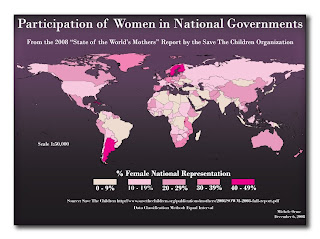
Saturday, December 6, 2008
Saturday, November 15, 2008
Lab 10
Monday, November 10, 2008
Lab 9
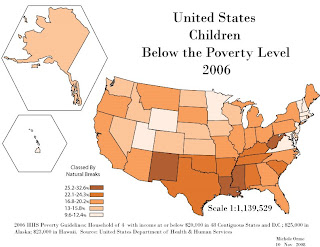 This is a color version of Lab 7. The color versions, both hard and soft copy, display better than the grey scale version from Lab 7. To contrast the hard and soft copies, the printed version shows greater color changes. Specifically the two darkest colors on the hard copy are contrast more than when posted in the blog. However the two lightest colors contrast more with eachother than in the digital version. The lightest color on the digital version almost appears white whereas it is more tan on the hard copy. The only difference I would make, now that I can see the hard copy, is I would make the lightest color a little darker so as to not appear so white when seen on the computer screen.
This is a color version of Lab 7. The color versions, both hard and soft copy, display better than the grey scale version from Lab 7. To contrast the hard and soft copies, the printed version shows greater color changes. Specifically the two darkest colors on the hard copy are contrast more than when posted in the blog. However the two lightest colors contrast more with eachother than in the digital version. The lightest color on the digital version almost appears white whereas it is more tan on the hard copy. The only difference I would make, now that I can see the hard copy, is I would make the lightest color a little darker so as to not appear so white when seen on the computer screen.Saturday, November 1, 2008
Lab 8
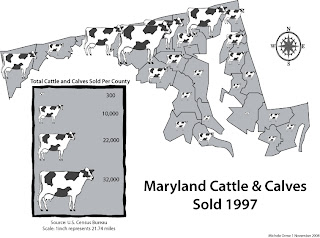 This was a lab on proportional symbols. We pretended that the state of Maryland asked us to create a grey-scale map (we haven't had our color lesson yet) depicting the relative density of census data for each county. In a proportional symbol map, a symbol (cow) is scaled to various sizes to depict the relative magnitude of some value. Proportional symbol maps scale symbols to continuous sizes. Graduated symbol maps only scale symbols to discrete sizes.
This was a lab on proportional symbols. We pretended that the state of Maryland asked us to create a grey-scale map (we haven't had our color lesson yet) depicting the relative density of census data for each county. In a proportional symbol map, a symbol (cow) is scaled to various sizes to depict the relative magnitude of some value. Proportional symbol maps scale symbols to continuous sizes. Graduated symbol maps only scale symbols to discrete sizes.Tuesday, October 28, 2008
Lab 7
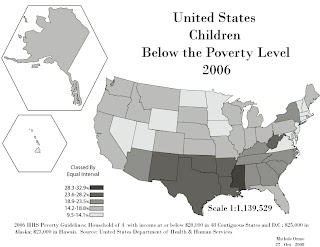
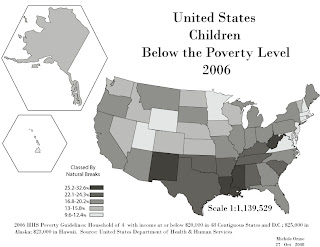
Lab 7: Grayscale Choropleth Maps of the 50 States
Comparison of Natural Breaks and Equal Interval
The map classed by equal interval gives an impression at first glance of a split between northern and southern states and shows a clumping of southeastern states. The natural breaks classified map appears more diverse. If I were to really use Natural Breaks I would have split it into many more categories but was limited to five for eye ease (especially since we were told to create the map in grayscale).
Choropleth Map
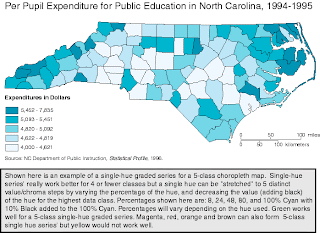 This is an example of a choropleth map courtesy of http://personal.uncc.edu/lagaro/cwg/color/Choro5-SingleHueGood.gif
This is an example of a choropleth map courtesy of http://personal.uncc.edu/lagaro/cwg/color/Choro5-SingleHueGood.gifFriday, October 10, 2008
Lab 6

This is a Dot Map. The idea was that the Census Bureau was interested in creating a map depicting the distribution of Veterans in West Virginia. I was provided a data file that didn't indicate a year the data was collected so I left it off of the map. According to our lab assignment and text book, Dot maps are used to provide a visual impression of relative density.
Thursday, October 9, 2008
Dot Map
Commercial Wireless Antennas in the USA
 Courtesy: http://personalpages.manchester.ac.uk/staff/m.dodge/cybergeography/atlas/wireless.html
Courtesy: http://personalpages.manchester.ac.uk/staff/m.dodge/cybergeography/atlas/wireless.html
Lab 5
Saturday, September 27, 2008
Friday, September 26, 2008
To The Moon!
Courtesy http://mrlovephysics.wordpress.com/
This map shows artificial objects on the surface of the Moon. The map does not include smaller objects like the golf balls from Alan Shepard's lunar driving practice during Apollo 14 or the Fallen Astronaut statuette left by the crew of Apollo 15.

Saturday, September 20, 2008
Tuesday, September 16, 2008
Clean Coal?
This is a link to maps related to Mountaintop Removal Coal Mining.
http://www.ohvec.org/issues/mountaintop_removal/maps/index.html
http://www.ohvec.org/issues/mountaintop_removal/maps/index.html
Saturday, September 13, 2008
Thursday, September 4, 2008
Links
Our first assignment is to post five links to geography related websites. The first two were chosen by the professor. The last three were my choice.
http://geog310.blogspot.com/ is our class website (Introduction to Digital Cartography). It has our professor's picture and a link to Census 2000 maps showing U.S. population and diversity maps.
http://www.gmu.edu/departments/geog is George Mason's Department of Geography website. It has a link for geography employers.
http://www.geoeye.com/ is the company for which I work. It is listed on the previous link as a geography employer in the private sector. GeoEye is currently hiring Geospatial Analysts in Dulles VA.
http://www.stopmountaintopremoval.org/ is a site dedicated to the stop of mountaintop removal. This is a cause to which I contribute and did a project on in my "Conservation of Natural Resources" class. People should be educated on the toxicity and destructive nature of "clean coal".
http://gos2.geodata.gov/wps/portal/gos is the geodata.gov website for U.S. Maps and data which contains federal, state and local geographic data. This site has a lot of special interest pages for real world geography.
http://geog310.blogspot.com/ is our class website (Introduction to Digital Cartography). It has our professor's picture and a link to Census 2000 maps showing U.S. population and diversity maps.
http://www.gmu.edu/departments/geog is George Mason's Department of Geography website. It has a link for geography employers.
http://www.geoeye.com/ is the company for which I work. It is listed on the previous link as a geography employer in the private sector. GeoEye is currently hiring Geospatial Analysts in Dulles VA.
http://www.stopmountaintopremoval.org/ is a site dedicated to the stop of mountaintop removal. This is a cause to which I contribute and did a project on in my "Conservation of Natural Resources" class. People should be educated on the toxicity and destructive nature of "clean coal".
http://gos2.geodata.gov/wps/portal/gos is the geodata.gov website for U.S. Maps and data which contains federal, state and local geographic data. This site has a lot of special interest pages for real world geography.
Subscribe to:
Comments (Atom)











